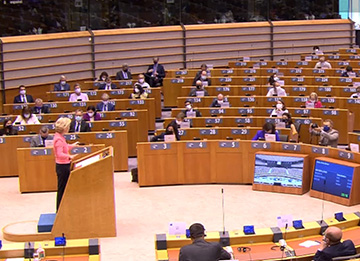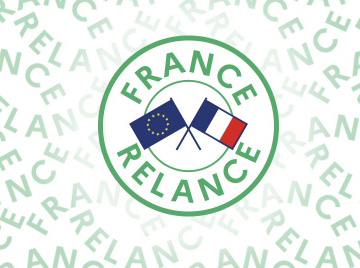
EC President Ursula von der Leyen addresses the European Parliament in her 2020 State of the Union speech. [Image: European Commisssion video]
On 16 September 2020, Ursula von der Leyen, the president of the European Commission, delivered an address on the state of the European Union, to a sparse, socially distanced group at the European Parliament (plus a much larger online audience). Among other things, the address spun an ambitious science and technology vision for the continent: advanced biomedical research and development; a recommitment to the European Green Deal to fight climate change; expanded efforts in data, AI and digital infrastructure.
Meanwhile, the government of the United Kingdom, which exited the EU in December, is reportedly at work on a revamped industrial strategy for the post-Brexit era, with the lofty aim of “building a new industrial revolution,” according to a recent article in the Financial Times. And the government has pledged a doubling of public research funds for science and technology within four years, with a particular focus on areas with broad societal relevance.
All of this sounds auspicious for research support in photonics, a key technology underlying many targeted areas in the mission-driven approach that now informs European science policy. Yet it takes place amid a nascent second wave of coronavirus infections in many countries, and continued obstacles to a workable post-Brexit EU–U.K. trade agreement. Those factors have injected uncertainty into the grand visions for research funding being articulated on both sides of the Channel.
Science funding in Europe and the U.K. is a huge and complex area, and other stories in the coming months will explore some specific, interesting pieces of the puzzle. For now, here’s a look at a few headline developments in the past quarter.
Overshadowed by COVID and Brexit
Inevitably, the vast new expenditures required to address COVID-19’s economic dislocations will constrain the prospects for research funding, whether at the EU or country level. In mid-July, the heads of EU member states committed to a continent-wide, seven-year pandemic recovery fund amounting to €750 billion (around US$878 billion at current exchange rates). The fund will be underwritten by massive new EC borrowing on the capital markets, and will be shared out to member states based largely on the relative economic harm inflicted by the pandemic.
The recovery fund pumps up the EU’s 2021–27 budget from €1,074 billion to more than €1,800 billion—a reflection of the immense economic challenges that the pandemic has posed for the continent. And that is only at the level of the EU. Its individual member states each face their own sobering (and expensive) task of pulling their economies back from coronavirus-induced chaos, as does the recently exited United Kingdom.

And, of course, future relations between the post-Brexit U.K. and continental Europe also remain an open question, as U.K.–EU trade negotiations have seemed hopelessly snagged on issues related to fishing rights and state aid. On 3 October, von der Leyen and the U.K. prime minister, Boris Johnson, undertook a weekend phone call to try to find a way forward, and emerged from the chat pledging to work together to break the logjam.
The personal engagement of the two leaders appears to have increased optimism on the prospects for a deal. Still, much work remains on the details—and given the need for ratification by the EU Parliament, any agreement would need to be reached by the end of this month.
Horizon Europe blues
For EU-wide science support, one recent casualty of the COVID–Brexit double-whammy has been funding levels for Horizon Europe, the framework program that will cover EU-financed R&D investment between 2021 and 2027. Hopes had been high that this ninth framework program would receive a significant funding boost compared with its immediate predecessor, Horizon 2020.
Ambitions for the program, however, had been dimming even before the pandemic year began. And in July 2020—at the same budget summit that led to the establishment of the pandemic recovery fund—the EU heads of state also agreed to slash the planned seven-year Horizon Europe budget from a previously proposed €94.4 billion to only €80.9 billion (in 2018 euros). Of that reduced number, €5 billion would come as a one-time infusion from the €750 billion recovery fund.

By the end of September, the EU’s research ministers had agreed on the final details of how the scaled-back Horizon Europe budget would be implemented. Their plan envisions cuts in most components of the program. For example, the European Research Council (ERC), the main EU-level funding agency for fundamental research, stands to have its 2021–2027 budget clipped by nearly 10% from the levels proposed by the EC in 2018.
The budget now goes to the European Parliament for negotiation. There, it could face substantial opposition, and pressure to reverse some of the Horizon Europe reductions. Christian Ehler, a German member of the European Parliament who serves as the body’s rapporteur on the Horizon Europe decision, accused the EU heads of state of a “disastrous lack of ambition on research and innovation” in the “savage cut.”
Country-level developments
The EU-level funding represented by Horizon Europe, of course, constitutes only a fraction of total spending on research and development across the continent. A much larger share comes from spending by EU member states and industry. But the pandemic crisis has also put national research budgets under pressure—which, according to some commentators, makes EU-level support and leadership that much more important.
That said, some of the bigger EU member states have put forward their own ambitious pandemic recovery plans, with at least some potential near-term impact on innovation spending.

The government of France bills its €100 billion France Relance(France Relaunch) recovery program as “a roadmap for the economic, social and ecological overhaul of the country.” [Image: gouvernement.fr]
In June, for example, the German government agreed on a €130 billion “Kraftpaket Deutschland” (Powerhouse Germany) post-pandemic recovery package. The plan includes a €50 billion future allotment to invest in targeted areas such as green-technology development, artificial intelligence and quantum computing. The “France Relance” (France Relaunch) program unveiled in September, meanwhile, envisions recovery spending of €100 billion in the next two years, with at least some of the money targeted for investment in green technologies and efforts to improve industrial competitiveness and innovation.
Across the Channel, the U.K. government has pledged a significant hike to its research funding, in light of its exit from the EU and continued uncertainties regarding its future participation in Horizon Europe. The government has declared that it will increase its public R&D funding from approximately £11 billion (US$14.2 billion at current rates) in 2020–21 to £22 billion in 2024–25, and boost overall U.K. investment in R&D to 2.4% of the country’s GDP by 2027 (versus 1.7% in 2016).
Missions and challenges
As the incomplete sample above suggests, the pandemic in particular has put research funding levels across Europe into a state of flux. What that might mean for an area like photonics, however, depends not only on the absolute amount of funding, but also on where the money is being spent. Here, there have been some interesting developments as well.
One such trend, both in the U.K. and the EU, has been an apparent shift away from discipline-specific funding, and toward an approach more focused on large-scale societal “grand challenges” or missions. “I think funding and interest in science around the challenges is increasing, and has really never been stronger than it is now,” says Matthew Wasley, the knowledge transfer manager for photonics at the U.K.-based Knowledge Transfer Network (KTN), an organization that works to forge connections among networks of innovators and funders in academia, government and industry.
Wasley acknowledges that there’s “always a balance” regarding how the challenges are defined (and by whom), and uncertainty on which technologies might be relevant. Yet he sees a prominent role for photonics as an enabling technology in many of the priority areas emerging both in the U.K. and Europe.
“An interesting place to be”
As one example, Wasley points to the U.K.’s Industrial Strategy. Over the past several years, he notes, that strategy has included a Challenge Fund built around themes such as accelerating disease detection, commercializing quantum technology, digital security, electric vehicles, decarbonization and net-zero-emission technologies and smart manufacturing. “For photonics and other enabling technologies, this is an interesting place to be,” Wasley says. “You won’t see photonics there” by name in any of those areas, yet “photonics actually addresses most of those,” opening opportunities for photonics companies and academic groups to participate.
A study from the U.K. Photonics Leadership Group included a “sticky-note” diagram showing 70 research topics in photonics bearing on contemporary grand challenges. [Image: UKPLG] [Enlarge image]
A September 2020 study from the U.K. Photonics Leadership Group (UKPLG), an organization that advocates for the British photonic industry, underscored the point. The report identified and discussed 70 photonics “research topics” that it said could prove important “in the context of nine ‘great challenges’” including data, health and aging, physical pollution, mobility and transport, climate change, defense and security, “economic patriotism” and food production.
The EU has spelled out a similar mission-driven approach for at least part of its Horizon Europe spending. In late June 2020, a team of “high-level independent experts” proposed five broad missions for the program, built around conquering cancer; resilience and adaptation to climate change; restoring marine ecosystems; a move toward “climate-neutral cities”; and soil and food health. Photonics has a place in realizing many of those priorities, Wasley maintains, including energy savings through all-optical communications and smart lighting, sensors for sniffing out disease and assessing plant health, smart-city technology and other areas.
Tackling sweeping goals
The focus on sweeping goals seems likely to continue to shape funding policy in the largest sense, as societies continue not only to battle the coronavirus, but also to seek equity, more livable cities and answers to longer-term threats such as climate change.
A new R&D roadmap released by the U.K. government in July 2020, for example, specifically articulated the goal of “applying research to solving our most pressing problems in government, industry and across society.” The document also expressed a new willingness to invest in so-called moonshots—“ambitious, measurable goals which could have a significant impact on an important societal issue.” In Brussels, meanwhile, in a visionary turn of phrase in her state of the EU address, EC President von der Leyen set as the task “to not only repair and recover for the here and now, but to shape a better way of living for the world of tomorrow.”
The previously mentioned UKPLG report, writing from the perspective of the British industry, took a particularly expansive view of where photonics might fit into such an ambitious agenda. “Photonics innovations,” the study authors wrote, “will be vital to tackling almost all the major challenges facing 21st-century society.”

